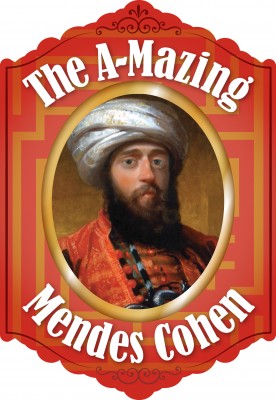Getting to Know Mendes


Mendes I. Cohen was born in Richmond VA in 1796, the son of a German Jewish father and an English Jewish mother. His family moved to Baltimore in 1807 and lived until 1879. He was a witness to many events in history both at home and abroad and a participant in a surprising number of transformational moments. Here are a dozen highlights:
1. Mendes is one of six Jewish defenders of Ft. McHenry during the Battle of Baltimore. When one bomb falls into the powder magazine rather than “bursting in air”, Mendes and two other artillerymen are sent in to rescue the ammunition. (To Mendes’ great fortune, the bomb was a dud)
2. The Cohen family starts out in the lottery business. Mendes and his brother are sent to Norfolk to sell DC lottery tickets (federal lottery tickets). Virginia authorities arrest the Cohens for selling tickets without the authority of the state of Virginia. The case of Cohens v. Virginia goes to the Supreme Court where Chief Justice Marshall technically rules against the Cohens, but establishes the principle that the Court has standing in resolving differences between state and federal authority.
3. The Cohen family is very active in the campaign for “The Maryland Jew Bill”. Finally passed in 1826, the bill allows people to serve on juries, serve in the militia and serve in public office without taking an oath to the New Testament. Mendes will later provide assistance to English Jews fighting for the same liberties in the 1830s.
4. Thanks to the success of his family’s banking enterprise, Mendes Cohen is able to “retire” at 33 and start an extensive tour of Europe and the Middle East. His first stop is England where he combines business with pleasure, dining with Nathan Rothschild and striking up a friendship.
5. Mendes arrives at the barricades in Paris just two weeks after the Student Revolt (think “Les Miserables”) and reports some disappointment in having just missed the action.
6. When in Rome, Mendes is invited to the installation of the new pope (Pope Gregory XVI). He writes a letter dedicated to the thorny question of whether a Jewish American democrat should kiss the feet of the pope.
7. Mendes decides to take up Egyptology. He sails down the Nile in a boat with an American flag of his own design, acquiring rare antiquities. The artifacts he collects are later purchased by Johns Hopkins University and are today the core of their archeology collection.
8. Mendes heads for Palestine, becoming the first American to ever acquire a firman (permit) from the Ottoman sultan to visit the Holy Land. Mendes spends his time trying to trace places mentioned in biblical passages.
9. After returning to the US, Mendes becomes a special assistant to Governor Veazey. He is asked to serve as Maryland’s representative at the coronation of Queen Victoria in 1837.
10. Mendes becomes one of the early directors of the B&O Railroad and Baltimore’s first Jewish charity, the Hebrew Benevolent Society. The Cohen brothers are very involved in the development of Baltimore’s first and only Sephardic synagogue in the 1850s.
11. Mendes is elected to the State House of Delegates in 1846. He votes for leniency in the sentencing of debtors. But as a loyal Democrat he also votes to condemn Pennsylvania for helping Maryland’s slaves escape to freedom.
12. Mendes spent his final years near his home in the Mount Vernon neighborhood of Baltimore (Mendes lived with his mother and then his brothers for his entire life). He spent his last years in the 1870s recounting tales of his youth to passersby, intensely proud of his adventures.

5 replies on “Getting to Know Mendes”
With a father born in Germany (an Ashkenazi) and a mother in England, where do Mendes Cohen’s Sephardi roots originate? I assume he had Sephardi ancestry, as an explanation of his involvement in founding Baltimore’s Sephardi synagogue.
Hi Joshua!
Based on our research we believe his mother, who was from Bristol, England, was Sephardi. There was a Sephardi community there during the time period.
You can read a little more about the Sephardi of England here: http://www.sephardicstudies.org/uk.html (you might even recognize a name or two!).
Thanks for writing in and I hope you have a chance to see the exhibit in person!
Best,
Rachel Kassman
Development & Marketing Manager
I saw the exhibit Sunday and enjoy it immensely.
I noticed two errors. The exhibit timeline states that the first telegraph transmission originated from the US Supreme Court building in 1844. At that time, the Court sat in the US Capitol basement. The US Supreme Court building opened in 1935.
Also, the brochure accompanying the exhibit under the heading “Choices and Identity” cites “avoiding the debacle at Blandensburg.” It should read Bladensburg.
Glad you enjoyed the exhibit! And thanks for sharing those corrections.